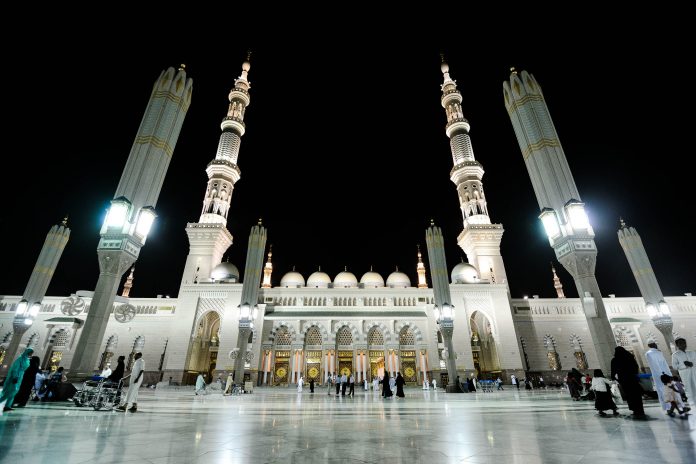In der opulenten Prophetenmoschee im Zentrum von Medina in Saudi-Arabien liegt der Prophet Mohammed begraben. Jedes Jahr besuchen zwei Millionen muslimische Pilger die zweitheiligste Stätte des Islam.
Die Masjid al Nabawi, besser bekannt als die Prophetenmoschee, in Medina ist nach der al-Haram-Moschee in Mekka die zweitheiligste Stätte des Islam. Sie beherbergt unter der berühmten „Grünen Kuppel“ die letzte Ruhestätte Mohammeds und bildet mit der al-Haram-Moschee und der al-Aqsa-Moschee in Jerusalem die drei heiligsten Stätten des Islam.
Ebenfalls nach der al-Haram-Moschee ist die Prophetenmoschee auch die zweitgrößte Moschee der Welt. Mit ihren gewaltigen Ausmaßen bietet sie einen wahrlich überwältigenden Anblick.
Inhaltsverzeichnis
BILDER: Prophetenmoschee in Medina
Fotogalerie: Prophetenmoschee in Medina
Errichtung der Prophetenmoschee
Das erste Gebäude auf dem heutigen Platz der Prophetenmoschee war das Haus des Propheten Mohammed selbst. Es wurde im Jahr 622 gemeinsam mit einer Moschee errichtet, die auch gleichzeitig Gemeinschaftszentrum und Schule war. Von einer erhöhten Plattform wurden die Lehren des Koran verkündet.
Wäre nicht die al-Quba-Moschee etwas außerhalb von Medina, wäre die Masjid al Nabawi die erste je gebaute Moschee. Die architektonische Basis der Moschee mit mehreren Toren, einem beschatteten Platz fürs Gebet und einem Innenhof wurde seither für alle Moscheen rund um den Globus verwendet.
Schon sieben Jahre nach dem Bau wurde die Moschee aufgrund der steigenden Anzahl der Muslime auf die doppelte Größe von 50 mal 50 Metern erweitert (heute ist sie etwa 100 mal so groß). Weitere Erweiterungen wurden von den verschiedensten Herrschern vorgenommen, von den Umayyaden und Abbasiden über die Mamluken und Türken bis hin zu den Saudis.
Im 20. Jahrhundert wurde die Moschee unter den saudischen Herrschern zu einem wahrlich gewaltigen Grabtempel ausgebaut. Im Jahr 1909 war die Prophetenmoschee das erste Gebäude der arabischen Halbinsel, das mit elektrischem Licht ausgestattet wurde.
Die Moschee, die unter den Osmanen gebaut wurde, ist von den vier inneren Minaretten abgegrenzt. Die sechs äußeren Minarette wurden unter dem Saudi-König Fahd errichtet und umrunden die „neue Moschee“, die ganz und gar mit kostbarem Marmor ausgelegt ist. Die zehn Minarette der Prophetenmoschee streben bis zu 105 Meter in die Höhe. Auch Muhammad Bin Laden, Vater des späteren Al-Qaida-Führers Osama bin Laden, war maßgeblich an der Erweiterung der Prophetenmoschee beteiligt.
Besuch der Prophetenmoschee

Die Prophetenmoschee hat eine enorme Kapazität von 1,6 Millionen Gläubigen. Zum Haddsch, der traditionellen Pilgerreise nach Mekka, besuchen viele Pilger auch Medina und so kann die Moschee noch auf zwei Millionen Besucher aufgestockt werden. Rund um die Moschee im Zentrum von Medina versorgen zahlreiche Hotels, Shops und Märkte die Massen an Pilgern, die vor allem während des Haddsch nach Medina reisen.
Die Masjid al Nabawi ist überhaupt eine der bedeutendsten Pilgerstätten des Islam. Laut Mohammed ist ein Gebet in „seiner“ Moschee tausend mal mehr wert als ein Gebet, das in jeder anderen Moschee gesprochen wird (außer in der al-Haram Moschee in Mekka und in der al-aqsa Moschee in Jerusalem). Dementsprechend ist die gesamte Moschee mit prächtigen Verzierungen geschmückt, für die die feinsten und kostbarsten Materialien verwendet wurden.
Gigantische Ausmaße der Prophetenmoschee

Der gewaltige Gebetssaal nimmt den ganzen ersten Stock der Prophetenmoschee ein. Er wird von 27 Kuppeln bedeckt, durch die das Sonnenlicht fällt. Wenn nötig, kann auch das Dach der Moschee zum Gebet genutzt werden. Dann werden die Kuppeln ausgefahren, um Schatten zu spenden.
Auch der Innenhof der Moschee wird mit riesigen Sonnensegeln vor der sengenden Sonne geschützt, wenn sich die Massen zum Gebet einfinden. Innerhalb der Moschee ist es angenehm kühl, der gesamte Prachtbau ist klimatisiert.
Rawdah – Das Grab des Propheten Mohammed

Die Masjid al Nabawi beherbergt die letzte Ruhestätte des Propheten Mohammed und zweier früher Führer des Islam, Abu Bakr und Umar. Unter der dunkelgrünen Kuppel (Qubbat al-Nabi) in der südwestlichen Ecke ruhen die sterblichen Überreste des Propheten.
Im Jahr 1837 wurde die zuallererst hölzerne Kuppel das erste Mal grün bemalt und mittlerweile ist sie weithin als die „Grüne Kuppel“ bekannt. Die Rawdah ist mit einem grünen Zaun umgeben, von Freiwilligen bewacht und im Gegensatz zum roten Teppich im Rest der Masjid al Nabawi mit dunkelgrünem Teppich ausgelegt.
Riad ul-Jannah – Der Garten des Paradieses
Zwischen der Rawdah und der Minbar (der erhöhten Kanzel, von der am Freitag gepredigt wird) befindet sich der Riad ul-Jannah, denn Mohammed soll gesagt haben, dass der Raum zwischen seinem Haus und einem minbar einer der Gärten des Paradieses ist.
Wünsche, die hier ausgesprochen werden, werden angeblich immer erfüllt. In den Riad ul-Jannah passen nur einige hundert Menschen, weswegen er vor allem während des Haddsch hoffnungslos überfüllt ist.
Kein Zugang für Nicht-Muslime!
Der Zutritt zur Moschee – sowie zum gesamten Zentrum von Medina – ist für Nicht-Muslime leider nicht gestattet. Nähert man sich dem so genannten „haram“, dem verbotenen heiligen Bereich, wird man an Checkpoints nach seinen Papieren gefragt und wenn diese nicht muslimisch sind, freundlich aber bestimmt um das Allerheiligste von Medina herum geleitet.





